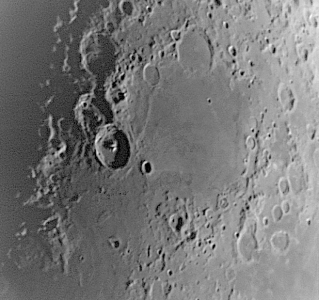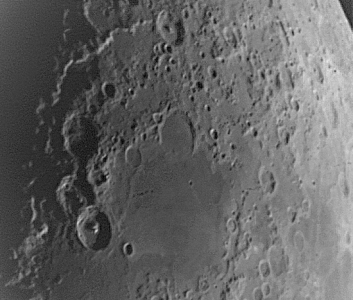A couple of days ago, I mentioned that I had gotten a Microsoft Cinema HD webcam to convert for use in astrophotography. Today, I got my Meade ETX-90 out, and decided to give it a test on the daytime moon. Sadly, my mount’s tracking capabilities seem to be pretty glitchy: the autostar seems to be resetting at odd intervals, probably a power issue. So, I just recorded some short video using SharpCap and letting the Earth’s rotation carry the image across the sensor. Here’s an example of the raw footage, recorded at 800×600.
Pretty wavy, awfully blue, and not that impressive. But luckily, processing with modern image stacking software can work wonders. I used VirtualDub to save the images as an image sequence, and then used AviStack to analyze and stack the resulting images, followed by some contrast enhancement and wavelet filtering. Here’s the result:
Since, I’m going to take pictures, I should probably learn some of the names of the major lunar features. The large, smooth area in the center is the Mare Nectaris. The large crater with the central peak is Theophilus, which overlaps Cyrillus. The tiny crater in the middle of the sea is Rosse, and for a sense of scale, is about 12km across. The crater near the top that seems to have the Mare Nectaris flowing into it is Fracastorius.
Some other footage I snapped resulted in some other nice images:
This shows the area further south (which is toward the top, which includes the crater Piccolomini, and it’s associated overlapping satellite impact craters.
Not bad for a first try. I wonder what I could accomplish with real equipment.
Addendum: Try rewatching the video above, watching carefully for the Rosse crater in the middle of Mare Nectaris. It flickers into view just a few times in the five second capture, but is a clear and obvious feature in the processed video. Pretty neat.


On to Saturn! (High in the evening sky.)